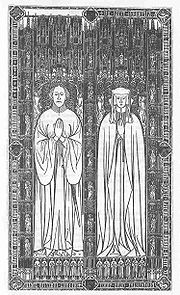
Brass rubbing
Encyclopedia

Great Britain
Great Britain or Britain is an island situated to the northwest of Continental Europe. It is the ninth largest island in the world, and the largest European island, as well as the largest of the British Isles...
enthusiasm for reproducing onto paper monumental brass
Monumental brass
Monumental brass is a species of engraved sepulchral memorial which in the early part of the 13th century began to partially take the place of three-dimensional monuments and effigies carved in stone or wood...
es – commemorative brass
Brass
Brass is an alloy of copper and zinc; the proportions of zinc and copper can be varied to create a range of brasses with varying properties.In comparison, bronze is principally an alloy of copper and tin...
plaques found in churches, usually originally on the floor, from between the 13th and 16th centuries. The concept of recording textures of things is more generally called making a rubbing
Rubbing
Rubbing is a reproduction of the texture of a surface with something to deposit marks, most often created with Charcoal, Wax, Crayons, Chalk, or various forms of Blotted and Rolled Ink...
. What distinguishes rubbings from frottage
Frottage (art)
In art, frottage is a surrealist and "automatic" method of creative production developed by Max Ernst.In frottage the artist takes a pencil or other drawing tool and makes a rubbing over a textured surface. The drawing can be left as is or used as the basis for further refinement...
is that rubbings are meant to reproduce the form of something being transferred, whereas frottage just desires to use rubbing to grab a random texture.
Brass rubbings are created by laying a sheet of paper on top of a brass (actually called "latten" - an alloy of brass and nickel) and rubbing the paper with graphite
Graphite
The mineral graphite is one of the allotropes of carbon. It was named by Abraham Gottlob Werner in 1789 from the Ancient Greek γράφω , "to draw/write", for its use in pencils, where it is commonly called lead . Unlike diamond , graphite is an electrical conductor, a semimetal...
, wax
Wax
thumb|right|[[Cetyl palmitate]], a typical wax ester.Wax refers to a class of chemical compounds that are plastic near ambient temperatures. Characteristically, they melt above 45 °C to give a low viscosity liquid. Waxes are insoluble in water but soluble in organic, nonpolar solvents...
, or chalk
Chalk
Chalk is a soft, white, porous sedimentary rock, a form of limestone composed of the mineral calcite. Calcite is calcium carbonate or CaCO3. It forms under reasonably deep marine conditions from the gradual accumulation of minute calcite plates shed from micro-organisms called coccolithophores....
, a process similar to rubbing a pencil over a piece of paper placed on top of a coin. In the "old days" rubbings were most commonly made using the equivalent of what we would call "butcher's paper
Butcher paper
Butcher paper is a kraft paper. Originally sold to butchers for the purpose of wrapping meat and fish, butcher paper is now used for a wide variety of purposes, notably in primary education where it is used for arts and crafts, such as hanging artwork. Many high schools use butcher paper for...
" [a 22–30 in (558.8–762 mm) roll of whitish paper] laid down over the brass and rubbed with "heelball", a waxy glob of black crayon once used to shine shoes.
Nowadays most brass rubbers purchase special paper rolls of heavy duty black velvety material, and the crayons are silver or gold (and other colours). Sometime after the early 1970s the authorities decided that you could no longer rub the original brasses since they were being worn away by the rubbing process, and the lack of care on the part of some individuals. Brass rubbing centres had already appeared around the U.K. and now they became the prime source for rubbings. It is important to note that one now rubs a replica brass, not the original. Replicas are often not the same scale as the original so a prospective buyer of a rubbing should investigate to see whether a rubbing is of an original or a replica. Miniature versions of brasses are also being offered for sale without specifying that they are not created to the original scale.

